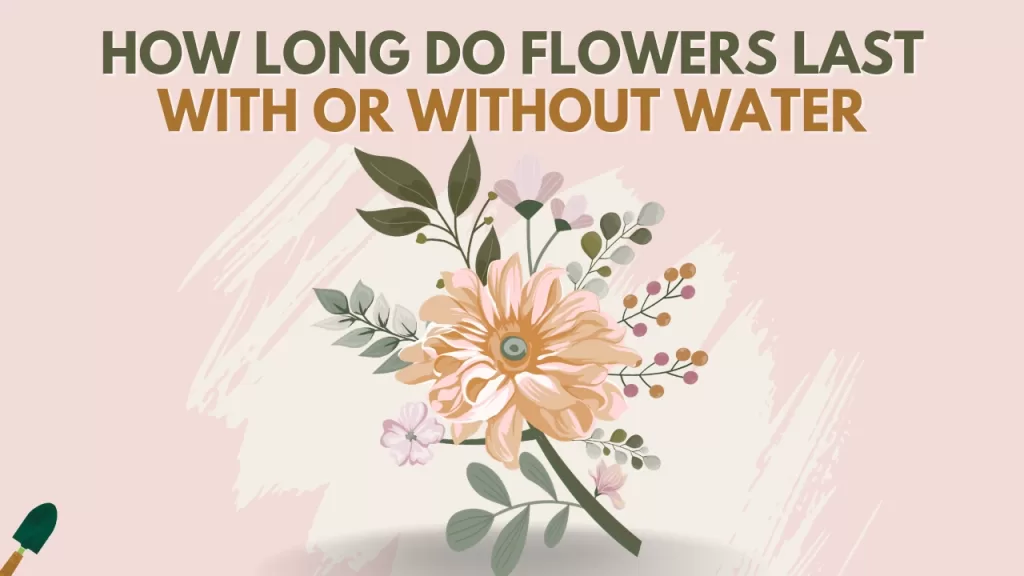If you are a gardening enthusiast or simply love the beauty of flowers, you may be wondering about the various types of flowers that exist. While there are numerous types of flowers, some are particularly unique due to their distinct characteristics.
In this article, we will explore stunning flowers that have 6 petals. These flowers come in different colors and sizes, and each has its own unique appearance and habitat.
We’ll discuss the habitat of each flower, its appearance, care, and maintenance. By the end of this article, you’ll be equipped with the knowledge you need to identify and care for these stunning flowers.
So, let’s dive in and explore the world of flowers with six petals!
List Of All The Six Petal Flowers
- Blue-eyed Grass Common (Sisyrinchium montanum)
- Cohosh – Blue (Caulophyllum thalictroides)
- Colicroot (Aletris farinosa)
- Hepatica Round-lobed (Anemone americana)
- Lily White Trout (Erythronium albidum)
- Star-of-Bethlehem (Ornithogalum umbellatum)
- Stargrass Yellow (Hypoxis hirsuta)
- Yucca (Yucca filamentosa)
- Bulbillenlose Feuerlilie
- Chionodoxa
- Anemones (Anemone coronaria)
- Freesia (Freesia spp.)
Petals – What, Why, and Importance about Petals
Before we dive into the specific flowers with six petals, let’s first discuss the importance of petals and their function. Petals are the colorful, often fragrant part of a flower that is responsible for attracting pollinators such as bees, butterflies, and birds. They are the reproductive structures of a flower, and their purpose is to help in the pollination process.
Here are a few important things to know about petals:
- Petals are modified leaves that surround the reproductive organs of a flower.
- They come in a variety of colors and shapes, and their size and shape can play a role in attracting specific pollinators.
- The number of petals on a flower can vary widely, with some flowers having only a few while others have hundreds.
- The arrangement of petals on a flower can also vary, with some flowers having petals that are arranged in a circular pattern, while others have petals that are arranged in a spiral pattern.
In addition to their function in attracting pollinators, petals also play an important role in the aesthetics of a flower. The color, shape, and size of petals can make a flower visually striking and beautiful to look at.
Many people enjoy growing and admiring flowers for their aesthetic qualities, and petals are a big part of what makes flowers so visually appealing.
Now that we’ve covered the basics of petals, let’s move on to the specific flowers that have six petals and learn more about each one.
Blue-eyed Grass Common (Sisyrinchium montanum)
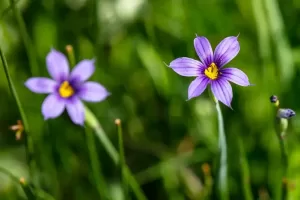
Blue-eyed Grass Common, also known as Rocky Mountain blue-eyed grass, is a small, clumping perennial that is native to North America. It is a member of the iris family and is known for its distinctive six-petaled flowers that bloom in late spring and early summer.
Here are some key characteristics of Blue-eyed Grass Common:
- Appearance: Blue-eyed Grass commonly has thin, grass-like leaves that grow in clumps up to a foot tall. Its delicate, light-blue flowers have six petals and a yellow center and are about half an inch in diameter.
- Habitat: This plant is native to the western United States, where it grows in a variety of habitats including meadows, prairies, and open woods.
- Care and Maintenance: Blue-eyed Grass Common is a relatively low-maintenance plant that prefers well-drained soils and full sun. It can be propagated by division in the fall or early spring and benefits from regular watering during periods of drought.
Some additional interesting facts about Blue-eyed Grass Common include:
- Despite its common name, Blue-eyed Grass is not actually a type of grass at all. It is a member of the iris family, which also includes plants like lilies and orchids.
- The flowers of Blue-eyed Grass Common are often visited by a variety of pollinators, including bees, butterflies, and moths.
- In addition to its ornamental qualities, Blue-eyed Grass Common has historically been used for medicinal purposes by some Native American tribes.
Overall, Blue-eyed Grass Common is a charming and relatively easy-to-grow plant that can add a touch of delicate beauty to any garden or landscape.
Cohosh Flower (Caulophyllum thalictroides)
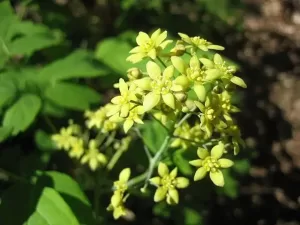
Cohosh flower is also known as Blue Cohosh, is a herbaceous perennial plant that is native to eastern North America. It is a member of the barberry family and is known for its small, delicate blue flowers that bloom in early spring.
Here are some key characteristics of the Cohosh flower:
- Appearance: Cohosh flower grows to be about two to three feet tall and has delicate, fern-like leaves that give it a lacy appearance. Its flowers are small and blue, with six petals and a yellow center.
- Habitat: This plant is native to the eastern United States, where it grows in rich, moist soils in shaded areas such as woodlands and stream banks.
- Care and Maintenance: Cohosh flower is a relatively low-maintenance plant that prefers moist, well-drained soils and partial to full shade. It can be propagated by seed or division in the fall or early spring.
Some additional interesting facts about the Cohosh flower include:
- In addition to its ornamental qualities, Cohosh-Blue has been used for medicinal purposes by some Native American tribes and in traditional herbal medicine.
- The name “cohosh” is derived from an Algonquian word meaning “rough,” which refers to the plant’s coarse, hairy stem.
- Despite its common name, Blue Cohosh is not actually a member of the cohosh genus, which includes plants like Black Cohosh (Actaea racemosa) and Red Cohosh (Cimicifuga racemosa).
Overall, Cohosh-Blue is a unique and attractive plant that can add a touch of woodland beauty to any garden or landscape.
Colicroot (Aletris farinosa)
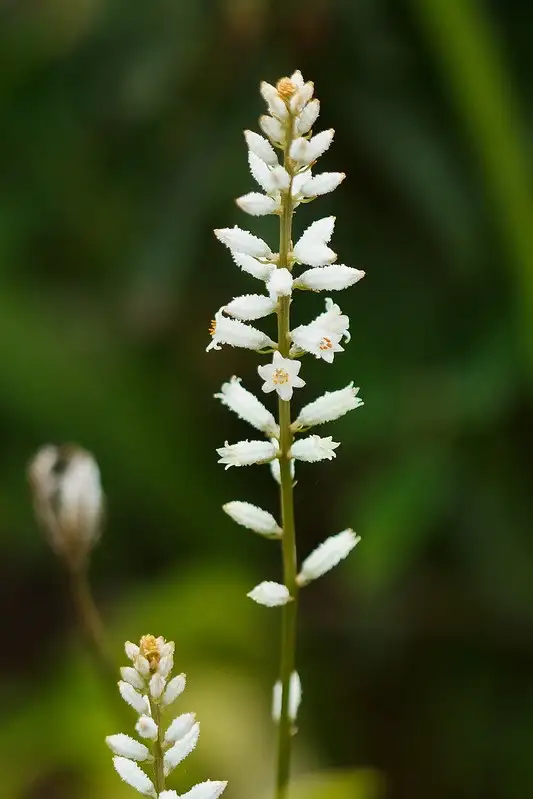
Colicroot is a perennial herb that is native to North America. It is also known as white colic root, ague root, and unicorn root. The plant produces a tall stem with narrow, green leaves that are arranged in a spiral pattern. It has a long history of use in traditional medicine for a variety of ailments.
Appearance
- Colicroot produces clusters of small, white flowers that each has six petals.
- The flowers are arranged in a tall, slender spike that can reach up to four feet in height.
- The plant’s leaves are long and narrow, measuring up to two feet in length.
- Colicroot produces a large, underground rhizome that is used in herbal medicine.
Habitat
- Colicroot grows in a variety of habitats, including open woods, meadows, and wetlands.
- It prefers moist, well-drained soil and partial shade.
- Colicroot is native to eastern North America and can be found from Ontario down to Florida and as far west as Texas.
Care and Maintenance
- Colicroot is a hardy plant that requires little care or maintenance once established.
- It can be propagated through the division of the rhizomes in the spring or fall.
- Colicroot prefers moist, well-drained soil and partial shade.
- It is not commonly grown as an ornamental plant but is sometimes used in wildflower gardens or naturalized areas.
Colicroot is a unique and interesting plant with a rich history of use in traditional medicine. Its clusters of small, white flowers with six petals make it a standout in any garden or naturalized area. With minimal care requirements, it can be a low-maintenance addition to any landscape.
Hepatica Round-lobed (Anemone americana)
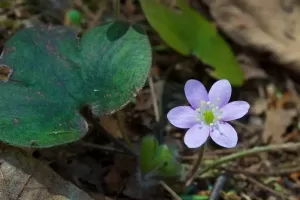
Hepatica Round-lobed, also known as Anemone americana, is a beautiful flowering plant native to North America. Here are some key features of this flower:
Appearance
- Hepatica Round-lobed has beautiful delicate flowers with six petals that bloom in early spring.
- The petals are usually blue, pink or white in color and are round to oval-shaped.
- The plant grows up to 6-12 inches in height with a spread of 6-12 inches.
Habitat
- Hepatica Round-lobed is found in woodlands, forests, and other shaded areas with well-draining soil.
- The plant prefers moist and cool environments and can be grown in USDA hardiness zones 3 to 8.
Care and Maintenance
- Hepatica Round-lobed is a low-maintenance plant that requires minimal care.
- The plant prefers moist soil, so watering should be done regularly to keep the soil moist but not waterlogged.
- Fertilizer should be applied in the spring to help promote healthy growth.
- Pruning is not necessary, but removing dead or damaged leaves can help the plant maintain its appearance.
Hepatica Round-lobed is a beautiful and easy-to-grow flowering plant that can add color and beauty to any garden.
Lily White Trout (Erythronium albidum)
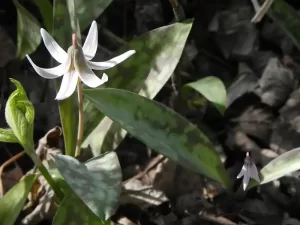
Lily White Trout is a beautiful wildflower that is native to North America. This plant gets its name from the trout-like speckled leaves. The flowers of the Lily White Trout have 6 petals and they bloom in early spring.
Appearance
- The Lily White Trout plant grows up to 6-12 inches tall.
- The leaves are oval in shape and green in color with brownish-purple speckles.
- The flowers are white in color with 6 petals that form a star-like shape.
- The petals are elongated and taper to a point.
- The Lily White Trout has a bulb-like structure that it uses to store nutrients and moisture.
Habitat
- The Lily White Trout prefers well-drained soil that is rich in organic matter.
- This plant grows in shady or partially shaded areas, such as under trees or along stream banks.
- It can be found in hardwood forests, wooded slopes, and meadows.
Care and Maintenance
- The Lily White Trout is a low-maintenance plant that does not require much care.
- It prefers moist soil but can tolerate some drought.
- This plant is resistant to most pests and diseases.
- The Lily White Trout will go dormant in the summer, and during this time it will not require any watering or fertilization.
- You can propagate Lily White Trout by division of the bulbs in late summer or early fall.
Lily White Trout is a lovely addition to any garden or natural area. With its trout-like leaves and delicate white flowers, this plant is sure to add beauty and interest to your landscape.
Star-of-Bethlehem (Ornithogalum umbellatum)
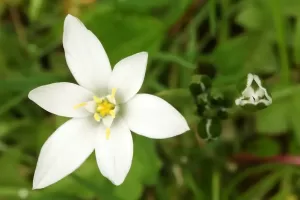
Star-of-Bethlehem, also known as Ornithogalum umbellatum, is a perennial flowering plant that belongs to the Asparagus family. It is native to Europe, North Africa, and West Asia. Here are some key features of the Star-of-Bethlehem:
Appearance:
- The Star-of-Bethlehem produces star-shaped white flowers with six petals that are each about 1 inch long.
- The flowers bloom in clusters on a tall stem, which can grow up to 1-2 feet tall.
- The leaves are narrow and grass-like, and they grow from the base of the plant.
Habitat:
- Star-of-Bethlehem prefers well-drained soils and partial to full sunlight.
- It can be found in meadows, grasslands, open woods, and along roadsides.
- The plant can grow in USDA hardiness zones 4-9.
‘
Care and Maintenance:
- Star-of-Bethlehem is an easy plant to grow and care for.
- It requires moderate watering and prefers to be kept in moist soil.
- The plant can be propagated through seeds or bulb division.
- It is best to plant bulbs in the fall or early spring, and they should be planted about 3-4 inches deep.
Overall, the Star-of-Bethlehem is a beautiful addition to any garden with its delicate white flowers and grass-like leaves. However, it is important to note that the plant is toxic if ingested and can cause vomiting and other symptoms, so it should be kept away from pets and children.
Stargrass Yellow (Hypoxis hirsuta)
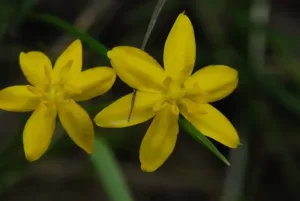
Stargrass Yellow, also known as Yellow Star Grass, is a native North American plant that belongs to the family Hypoxidaceae. It is a perennial herb that grows from a small, onion-like bulb and is characterized by its bright yellow star-shaped flowers. Here are some interesting facts about Stargrass Yellow:
Appearance:
- The plant typically grows to be 6-12 inches tall and has thin, grass-like leaves that are less than ¼ inch wide.
- The flowers of Stargrass Yellow bloom in the late spring and summer and are typically 1-2 inches in diameter with six yellow petals that curve backward, giving them the appearance of stars.
Habitat:
- Stargrass Yellow can be found growing in meadows, prairies, and open woods throughout much of the eastern United States.
Uses:
- Historically, Stargrass Yellow has been used by Native American tribes for medicinal purposes, including treating respiratory ailments and as a poultice for wounds.
- Stargrass Yellow is an important food source for pollinators such as bees and butterflies.
If you’re looking to add a pop of bright yellow color to your garden, Stargrass Yellow is a beautiful and low-maintenance option. Its unique star-shaped flowers and grass-like foliage make it a standout addition to any landscape.
Yucca (Yucca filamentosa)
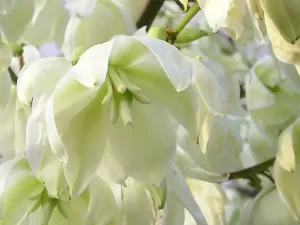
Yucca is a genus of perennial shrubs and trees in the Asparagaceae family. The Yucca filamentosa, also known as Adam’s needle, is a popular species in gardens and landscapes for its ornamental value. Here are some key facts about the Yucca filamentosa:
- Appearance: Yucca filamentosa has a rosette of long, sword-shaped leaves with sharp tips and edges. The leaves are evergreen, stiff, and pointed, growing up to 3 feet in length and 2 inches in width. The plant produces a tall spike of creamy white flowers with 6 petals in summer, which can grow up to 8 feet tall.
- Habitat: The Yucca filamentosa is native to the southeastern United States, particularly in coastal regions from North Carolina to Florida. It grows in sandy or rocky soils and is well adapted to dry, hot environments.
- Care and Maintenance: Yucca filamentosa is a hardy plant that is easy to grow and maintain. Here are some tips for cultivating and caring for Yucca filamentosa:
- Soil: The plant prefers well-drained, sandy soils, but can tolerate a wide range of soil types.
- Light: Yucca filamentosa prefers full sun, but can also grow in partial shade.
- Water: The plant is drought-tolerant and does not require frequent watering. Water sparingly, only when the soil is completely dry.
- Fertilizer: Yucca filamentosa does not require fertilizer, but can benefit from occasional applications of a balanced, slow-release fertilizer.
- Propagation: Yucca filamentosa can be propagated from seeds or by dividing the offsets that grow from the base of the plant.
- Uses: Yucca filamentosa is a popular plant for gardens and landscapes because of its striking appearance and low maintenance. It can be used as an accent plant or in a mixed border. The plant has also been traditionally used for medicinal purposes by indigenous peoples.
Bulbillenlose Feuerlilie
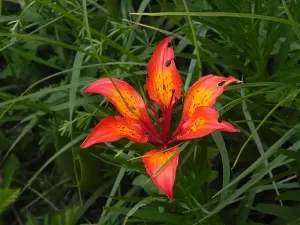
Bulbillenlose Feuerlilie, also known as Lilium bulbiferum var. croceum, is a beautiful and vibrant flower that is native to Europe and Asia. Here are some interesting facts about this flower:
Appearance:
- The Bulbillenlose Feuerlilie is a member of the lily family and is related to other lilies such as the Easter Lily and the Tiger Lily.
- It is a perennial plant that can grow up to 3 feet in height.
- The Bulbillenlose Feuerlilie blooms in the early summer and produces stunning orange-red flowers that are trumpet-shaped with 6 petals and can grow up to 4 inches in diameter.
- The flowers are usually arranged in a pyramid-shaped cluster and have a sweet, pleasant fragrance.
- One interesting feature of this flower is that it does not produce bulblets or bulbils, which are small bulbs that grow on the stem and can be used for propagation. Instead, it produces seeds that can be sown in the fall for the next season’s growth.
Habitat: The Bulbillenlose Feuerlilie prefers well-draining soils and a sunny or partially shaded location. It is also drought-tolerant and can survive in harsher conditions.
Uses: In some cultures, the Bulbillenlose Feuerlilie is associated with love, passion, and desire. It is sometimes used in weddings and other celebrations to symbolize these emotions.
Like many lilies, the Bulbillenlose Feuerlilie is toxic to cats and can cause serious illness or even death if ingested. It is important to keep this flower away from cats and other pets.
Overall, the Bulbillenlose Feuerlilie is a striking and fascinating flower that is sure to add color and beauty to any garden or landscape.
Chionodoxa
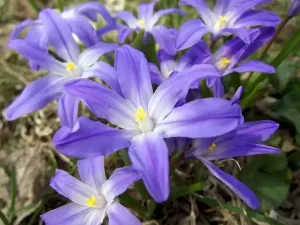
Chionodoxa, commonly known as Glory-of-the-Snow, is a small genus of bulbous plants native to the eastern Mediterranean region. They are popular ornamental plants in gardens and naturalized areas, known for their attractive blue, pink, or white star-shaped flowers that bloom in early spring.
Characteristics of Chionodoxa flower:
- The name Chionodoxa comes from the Greek words “chion” (snow) and “doxa” (glory), referring to the plant’s ability to bloom even in snow-covered ground.
- Chionodoxa plants are easy to grow and care for, making them a great choice for novice gardeners. They prefer well-drained soil and partial shade and can thrive in a variety of climates.
- The flowers of Chionodoxa are typically blue, but can also be pink or white. They have six petals that form a star shape and are about 2-3 cm in diameter.
- Chionodoxa plants bloom in early spring, often before other spring-flowering bulbs like tulips and daffodils. This makes them a great way to add color to your garden early in the season.
- Chionodoxa bulbs can be planted in the fall, before the first frost. They should be planted about 3-4 inches deep and 3-4 inches apart. If you’re planting multiple bulbs, it’s best to plant them in clusters or drifts for a more natural look.
- Chionodoxa plants are known for their ability to naturalize, meaning they can spread and multiply over time. This makes them a great choice for planting in large areas or meadows, where they can create a beautiful carpet of flowers.
Anemones (Anemone coronaria)
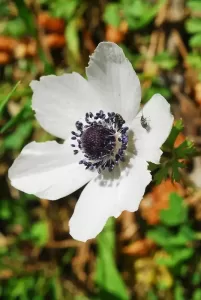
Anemones (Anemone coronaria) are lovely and colorful flowers that are native to the Mediterranean region. They have been cultivated for thousands of years and are popular for their bright colors and delicate appearance.
Characteristics of the anemone flower:
- Anemones are also known as windflowers, due to their Greek name “anemos,” which means wind.
- The anemone flower has been used in various cultures and traditions for medicinal and decorative purposes. In ancient Greece, the anemone was thought to help cure sickness and protect against evil spirits.
- Anemones are part of the buttercup family and are typically grown from bulbs.
- Anemones bloom in a variety of colors, including red, pink, purple, blue, and white. Some varieties also have bi-colored petals.
- Anemones have six petals, which are arranged in a circular shape around a prominent center.
- Anemones prefer well-drained soil and lots of sunlight and are typically planted in the fall for spring blooming.
Overall, the anemone flower is a beautiful addition to any garden or floral arrangement, and its long history of cultivation and symbolism make it an intriguing and meaningful choice for any occasion.
Freesia (Freesia spp.)
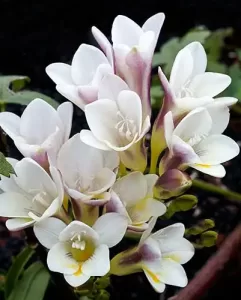
Freesia (Freesia spp.) is a genus of flowering plants native to South Africa. It is named after Friedrich Heinrich Theodor Freese, a German physician, and botanist. Freesia belongs to the family Iridaceae, which includes other popular ornamental plants such as crocus and iris.
Characteristics of the Freesia flower:
- Appearance: Freesias have trumpet-shaped flowers with six petals that flare out from a narrow tube. The petals can be single or double and come in a range of colors including white, pink, yellow, orange, red, purple, and blue. The flowers are usually sweetly scented and appear on long, slender stems.
- Blooming season: Freesias bloom in the spring and summer months, typically from April to July.
- Growing conditions: Freesias prefer well-drained soil and full sun or partial shade. They are often grown from corms (bulb-like structures) and are popular as cut flowers due to their long vase life.
- Symbolism: Freesias are often associated with friendship, trust, and innocence. In the language of flowers, they are also said to represent lasting friendship and thoughtfulness.
- Cultural significance: In South Africa, freesias are sometimes used in traditional medicine to treat a range of ailments including fever and colic. They are also a popular flower in weddings and other special occasions.
Overall, Freesias are a popular ornamental plant due to their delicate beauty and sweet fragrance. They are a great addition to gardens, floral arrangements, and as gifts for loved ones.
FAQs
What do six-petal flowers symbolize?
Six-petal flowers often symbolize a sense of balance and harmony. The number six is often associated with balance and stability, so these flowers can represent a sense of tranquility and calmness.
Are six-petal flowers easy to care for?
The care requirements for six-petal flowers vary depending on the species, but many of them are relatively easy to care for. As with any plant, it’s important to research the specific care requirements for the flower you have in mind to ensure it gets the proper care.
Can six-petal flowers be grown indoors?
Yes, many six-petal flowers can be grown indoors as long as they receive proper lighting and care. Some popular indoor options include freesia, tulips, and ranunculus.
Do all flowers have 6 petals?
No, all flowers don’t have 6 petals. The number of petals in a flower depends on various things which makes it unique and produce a different number of petals.
Conclusion
In conclusion, the world is filled with an abundance of beautiful and unique flowers, each with its own story and significance. From the delicate Lily White Trout to the vibrant Stargrass Yellow, and the elegant Yucca to the rare Lavoisiera francavillana, there is no shortage of fascinating blooms to discover.
Flowers have been a source of inspiration and admiration for humans throughout history, and they continue to fascinate us today. They are not just beautiful to look at, but they also serve important functions in our ecosystem, providing food and shelter for various species of insects, birds, and animals.
Whether you are a nature lover, a gardener, or simply someone who appreciates the beauty of nature, there is something special about each and every flower out there. So next time you come across a new and unfamiliar flower like 7 petal flowers or flowers with 8 petals, take a moment to appreciate its uniqueness and learn about its story. Who knows, it may just become your new favorite.


